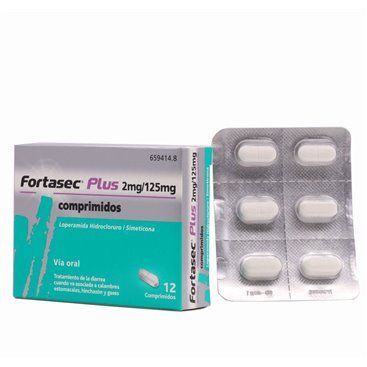Fortasec Plus 2/125 Mg 12 Tablets
Fortasec Plus provides fast and effective relief from acute diarrhea and abdominal discomfort caused by gas and bloating. Combining loperamide and simethicone, this dual-action medication stops symptoms quickly. Suitable for adults and teenagers, it’s easy to use and ideal for occasional digestive issues. Buy Fortasec Plus online today!
Fortasec Plus provides fast and effective relief from acute diarrhea and abdominal discomfort caused by gas and bloating. Combining loperamide and simethicone, this dual-action medication stops symptoms quickly. Suitable for adults and teenagers, it’s easy to use and ideal for occasional digestive issues. Buy Fortasec Plus online today!
Fortasec Plusfor Diarrhea and Gas Relief
Fortasec Plus offers a trusted solution for managing acute diarrhea and abdominal discomfort, including gas, bloating, and cramps. This dual-action medication, combining loperamide and simethicone, provides fast relief so you can return to your normal activities quickly.
What is Fortasec Plus, and What is it Used For?
This treatment is designed to stop diarrhea while easing abdominal discomfort caused by gas.
- Loperamide slows bowel movements, helping your body absorb water and electrolytes to restore normal stool consistency.
- Simethicone breaks gas bubbles in the digestive system, reducing bloating and cramping.
Adults and teenagers aged 12 and older can use this medication for occasional diarrhea episodes with related symptoms.
How Does It Work?
This treatment works by addressing both the causes and symptoms of diarrhea:
- Loperamide reduces intestinal motility, helping your body retain fluids and firm up stools.
- Simethicone relieves abdominal pressure by breaking down gas bubbles in your digestive tract.
These two components work together to provide rapid and comprehensive relief from digestive distress.
Fortasec Plus English Information
You can find reliable information about Fortasec Plus in English right here. This guide explains how to use the medication, including its benefits, dosage, and instructions. Fortasec Plus treats acute diarrhea and abdominal discomfort by combining loperamide and simethicone for fast and effective relief.
If you are looking for clear guidance, this resource ensures you understand every aspect of Fortasec Plus English usage. Get the answers you need and manage your symptoms confidently.
Who Should Use It?
This product suits:
- Adults and teenagers (12+ years) experiencing diarrhea episodes with gas or cramps.
- Individuals who need a fast, reliable solution to occasional digestive issues.
Consult a doctor if symptoms persist or worsen after two days of use.
Dosage and How to Take Fortasec Plus
Recommended Dosage:
- Adults (18+ years):
- Take 2 tablets initially, followed by 1 tablet after each loose stool.
- Do not exceed 4 tablets per day or use for more than two days.
- Teenagers (12–18 years):
- Start with 1 tablet, then take 1 tablet after each loose stool.
- Maximum 4 tablets per day, for no longer than two days.
Instructions for Use:
- Chew the tablets thoroughly before swallowing to ensure optimal absorption.
Buy Fortasec Plus Online
If you’re looking to buy Fortasec Plus tablets online, our store offers several benefits:
- Fast and secure delivery to your door.
- Access to authentic products at competitive prices.
- Easy and convenient ordering from your home.
Don’t let diarrhea or abdominal discomfort interrupt your day—shop now and experience quick relief.
Contraindications
Avoid this medication if you:
- Are allergic to loperamide, simethicone, or other ingredients in the formula.
- Have diarrhea with blood or caused by infections like Salmonella or Shigella.
- Suffer from conditions like intestinal obstruction or severe bloating.
Precautions
Take special care if you:
- Have liver problems, as the medication may accumulate in your body.
- Are severely dehydrated; rehydrate with oral solutions before use.
- Experience chronic digestive issues or have a compromised immune system, as complications may arise.
Tips for Managing Diarrhea
- Stay Hydrated
Drink plenty of water or oral rehydration solutions to replace lost fluids and electrolytes.
- Adjust Your Diet
- Eat bland foods like bananas, rice, applesauce, and toast.
- Avoid spicy, fatty, or high-fiber foods that could worsen symptoms.
- Rest and Monitor Your Health
Take time to recover, and avoid physical exertion. If symptoms persist after two days, consult a healthcare provider.
Be Prepared When Traveling
This medication is a great addition to your travel kit, offering quick relief during unexpected digestive troubles.
User Opinions
Users report that this treatment quickly stops diarrhea and relieves gas-related discomfort. It’s praised for its fast action and ease of use, though mild side effects like drowsiness or constipation occur rarely.
Side Effects
Most side effects are mild and infrequent, including:
- Digestive discomfort: Bloating, nausea, or dry mouth.
- Drowsiness or dizziness, especially in sensitive individuals.
- Allergic reactions, such as rash or swelling (seek immediate medical help if these occur).



